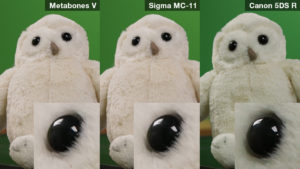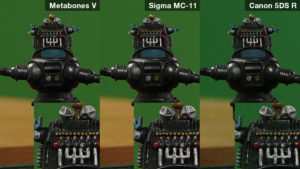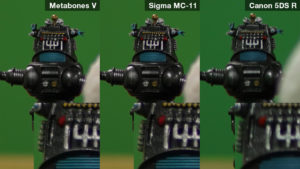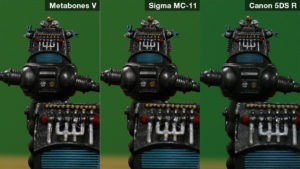Part three of our Canon EF to Sony E Mount Lens Adapter comparison. Click here for Part 1, and click here for Part 2.
How Well Did The E Mount Adapters Perform?
As mentioned previously, for each lens, we’ve set up similar shots with three different focal areas.
6. Sigma 50mm f/1.4 DG ø77 HSM Art
Each shot is 1/100 sec, f/4, ISO-1000, tripod mount with 2 second timer.
(Click on thumbnails to view side-by-side comparisons)
This Sigma is a top-of-the-line 50mm, and it shows—both cameras and both adapters focused quickly and captured impressively crisp, clear shots.
The picture quality seen in all combinations was equivalent, though showing the typical differences in color and contrast between the a7R III and the 5DS R.
7. Canon 18-135mm f/3.5-5.6 EFS IS Nano USM
Each shot is 1/60 sec, f/5.6, ISO-1000, tripod mount with 10 second timer.
(Click on thumbnails to view side-by-side comparisons)
This zoom lens performed relatively well on the a7R III with the Metabones V, giving us sharp and clear shots. However, it took a long time to gain focus, especially on the farthest target (the penguin).
Despite of our best efforts, we couldn’t get this 18-135mm lens to fit on the Sigma MC-11 adapter, and as an EFS lens, it did not fit the 5DS R. Therefore, we don’t have a comparison for this lens, unfortunately.
8. Canon 75-300mm f/4-5.6 III EF
Each shot is 1/60 sec, f/5.6, ISO-1000, tripod mount with 10 second timer.
(Click on thumbnails to view side-by-side comparisons)
This lens worked with both cameras and adapters, however there was a vast difference in the focusing time between the Sony a7R III with either adapter and the Canon 5DS R. The 5DS R acquired focus in 2-3 seconds, while we had to fiddle with the a7R III for minutes trying to get it to focus on anything with this lens. We weren't able to focus on the farthest target (the penguin) at all with either adapter, though the 5DS R was able to catch it in 1-2 seconds.
Once the Sony a7R III did focus on something, it definitely got a clearer picture than the 5DS R through this lens. In general, this lens is soft and blurry on the long end, but it is a budget lens, at about $200 new. Because of the unreasonably lengthy focus time, we don’t recommend this lens for use with an adapter.
9. Tamron SP 70-200mm f/2.8 Di VC USD
Each shot is 1/60 sec, f/5.6, ISO-1000, tripod mount with 10 second timer.
(Click on thumbnails to view side-by-side comparisons)
This Tamron did a superb job on all adapter-camera combinations we tested here. This is a high-end lens, and it definitely shows in the sharp, clean images we got with it.
Our Conclusions
The Metabones V and Sigma MC-11 both gave us very good photos, comparable to the lenses in native mount on a Canon camera, with no discernible quality loss. For photography, we would definitely recommend either of these if you have EF or EF-S Mount lenses that you want to use on a Sony E Mount camera. The only lens we had significant trouble with when using the adapters was the Canon 75-300mm III lens, and we suspect it may be because that is a relatively old lens, released in 1999.
The primary shortcoming we found was that, with either adapter and any lens, AF-C Face Tracking did not seem to work in video mode on our Sony A7R III. This severely limits the types of videography you could do with these adapters.
You could still shoot sitting interviews where the subject is relatively still (and AF-S could be used), timelapse video, or anything involving manual focus, but most other types of video would be much more difficult or impossible without access to AF-C.









No comments:
Post a Comment